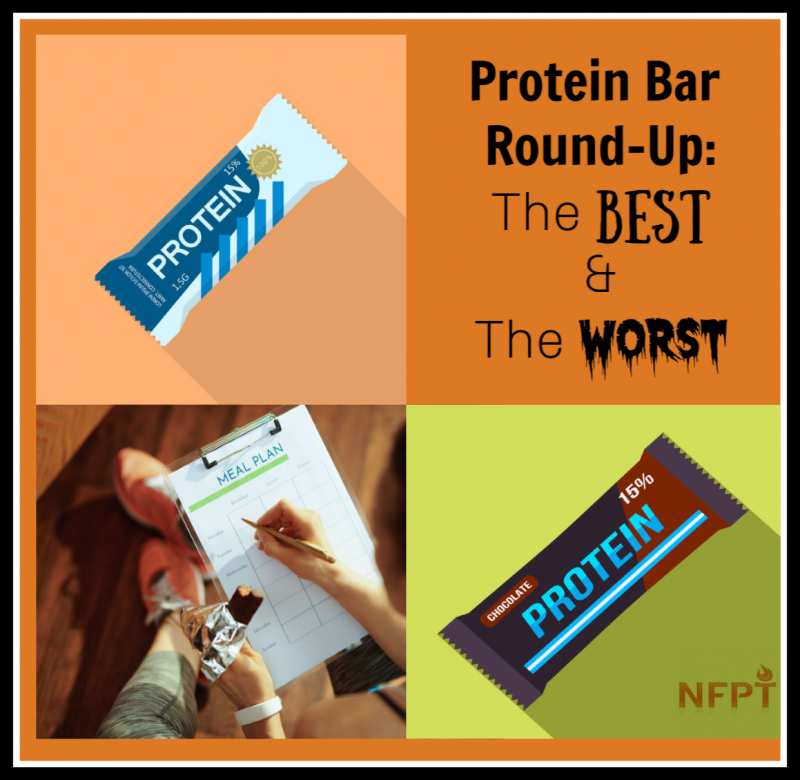
Are your clients looking to refuel after a challenging workout, bulk up for a competition, or just kaibosh hunger pangs for an hour or two? A protein bar lies within easy reach. However, with such an abundance of options available in the marketplace and online, selecting the best choice for one’s needs can lead to more confusion than clarity.
What Exactly Is In Protein Bars?
From a purely nutritional standpoint, many products are nothing more than candy bars in workout clothes. Very often the sugar content far exceeds the grams of protein, thereby stripping away at the very purpose of a “healthy” quick snack. The protein sources themselves are sometimes less than stellar; and stabilizers added to ensure longevity of the product’s shelf life can dramatically decrease that protein’s bioavailability. Thus, when a label claims that the bar delivers 25 grams of protein, often only about 15 grams function as a nutritive source. Seeking out a bar that meets all of one’s criteria, plus delicious flavor and palatable texture, becomes as challenging as that day’s gym workout.
Knowing The Client’s Needs
Assessing and determining the client’s ultimate goal is the first step in helping him or her choose a bar that fulfills the appropriate needs. A good starting point is to aim for bars containing at least 20 grams of protein from a pure source.
While casein, whey, or a combination thereof have long been staples in our industry, individuals with digestive sensitivities may seek bars made with alternative, usually plant, protein sources. Many newer companies offer a dazzling array of vegan bars, comprised of pea, hemp, soy and pumpkin protein. Occasionally egg whites are used, too.
After taking into account one’s total caloric needs, look for a bar delivering 300 calories or less, 10 grams or less of fat, fewer than 10 grams of added sugar, and at least 5 grams of fiber.
Kris Sollid, Registered Dietitian and Senior Director at the International Food Information Council Foundation, reminds us that a savvy comparison shopper should never overlook fiber. “While most younger men tend to eat enough protein, fiber is a different story,” she explains to MensHealth.com.
“Men only eat about half of the fiber recommended each day, so it’s important to incorporate it whenever possible.” Fiber facilitates the protein’s effective movement through the body. Delicious natural sources of fiber are raspberries, oatmeal, almonds, an orange, flaxseed, sweet potatoes and black beans.
Look For Natural Ingredients
In all food products, ingredients are listed in order of dominating percentage. An ideal bar lists the protein source first or second on the ingredients label, along with other whole foods such as nuts or oats/grains. Furthermore, ingredients should be recognizable and easy to pronounce, and not resemble substances found in a chemistry lab.
Please Those Tastebuds
Ask your client if he has a preference of sweet or savory, fruits or chocolate/vanilla flavors, and textures (crunchy or not). Once that has been established, look for companies that offer more than just a few flavor options within that parameter. If protein bars serve as a daily post-workout snack, variety adds interest, palatability and alleviates boredom.
Protein Isolate Vs. Concentrate
Another debate among experts is whether whey protein isolate or concentrate is the ideal post-workout choice. A 2004 protein study featured in the Journal of Sports Science and Medicine noted that during processing, whey protein isolate can easily become denatured, thereby lowering the potency of the protein. Opt for concentrate if it’s available.
Sugar Substitutes: Friend Or Foe?
Sugar alcohols — sorbitol, mannitol, xylitol, erythritol, and more — and sugar substitutes like and sucralose, sweeten products while keeping the sugar count low. At first glance, this may appeal to clients who are looking to trim calories, but sugar alcohols very often cause gas, bloating, or gastrointestinal discomfort for a large percentage of our population.
The human body was not designed to completely absorb sugar alcohols; they travel through the gastrointestinal tract rather than being absorbed into the bloodstream. Once there, fermentation may occur, leading to abdominal cramping, flatulence, and diarrhea.
Sucralose, the chemical substitute of sugar found in Splenda, has been linked to many undesirable healthy symptoms including, spiking insulin and blood sugar levels, despite being devoid of actual sugar.
Stevia-sweetened products may be tad more costly but provide a sweetened experience without the added sugars or abdominal side effects.
The Best And The Worst Protein Bars
After extensive research, I have compiled a brief listing of what expert review panels consider the best and worst protein bar choices on today’s market.
Worst Protein Bar Choices
ThinkThin (now “THINK!”) Chocolate Strawberry Bars
To compensate for the lack of sugar, this product is heavily loaded with 22 grams of sugar alcohols. Among these is maltitol, a low-calorie, plant-based sweetener that a study in the International Journal of Dentistry found to be linked to stomach and abdominal pain as well as excessive internal gas and flatulence.
Balance Bar Lemon Meringue Crunch
Balance Bars are low in fiber and contain chemicals such as carrageenan and caramel color. Carrageenan serves as a thickener and has been linked to gut inflammation in animal and human cell studies. While the U.S. Food and Drug Administration believes it is safe, those living with inflammatory bowel disorders may choose to sidestep this brand. According to a 2015 study conducted at Johns Hopkins University, caramel coloring is a potential carcinogen.
One look at the first several ingredients listed on this bar’s label clearly indicates the lack of whole-food ingredients: soy protein nuggets, glucose syrup, protein blend, sugar, fractionated palm kernel oil and palm oil. There is that chemistry-lab list again!
Green Superfood Energy Bars
Marketing companies love using attention-grabbing buzzwords such as “green,” “superfood” and “energy.” The savvy consumer quickly realizes that this bar packs 25 grams of sugar, which comprise nearly 50% of its total calories. While this variety does contain a healthy mix of green superfoods – powders, teas, roots and produce processed to fit in the bar – these can easily be ingested directly from their natural sources: fruit, vegetables, beans, legumes and grains. Experts agree that even the four grams of fiber cannot justify the high sugar content.
Best Protein Bar Choices
Crunchy Peanut Butter KINDBars
The nut butter and whole peanuts help this bar pack a significant amount of digestion-aiding fiber and muscle-maintaining protein. At 250 calories this bar provides 12 grams of available protein and eight grams of sugar.
Almond Honey Rise Bar
This brand delivers a product that is non-GMO, gluten free, soy free, and contains no added sugar. “Having a straightforward, simple ingredient bar like Rise in your back pocket makes it easy to avoid the impulse grab of junk food,” says Christina Meyer-Jax, MS, RDN, and Professor of Nutrition at St. Catherine’s University in St. Paul, Minnesota. “I like that they are a little higher in monounsaturated fats from the nuts, along with being high in protein. This is an ideal combo to help us feel fuller longer.” The 280-calorie bar delivers 20 grams of protein and four grams of fiber.
Health Warrior Chia Protein Bars
Plant-powered Health Warrior bars contain a unique protein blend of chia seeds, oats, quinoa and peas. Chia seeds offer fiber, antioxidants and anti-inflammatory omega-3 fatty acids. Clients seeking to minimize their intake may appreciate knowing how chia seeds turn into a gel when soaked in liquid, promoting a feeling of fullness and satiety. This particular bar is also a potent source of calcium, which can help at-risk women and adults over age 51 meet their needs.
These smaller sized bars are only 100 calories but provide 5 grams of fiber and only 3 grams of sugar. It’s a lower protein content at around 3 grams, but this is also 2 to 3 times smaller than your average protein bar.
EVO Hemp Cashew Cacao Bars
This brand’s simple ingredient list, coupled with protein derived from vegan hemp seeds, rated high among our expert panel. The sugar content is low, and the first three ingredients are whole foods: dates, cashews and apricots. Similar to chia, hemp contains omega-3 fatty acids. According to Registered Dietitian Alissa Rumsey, M.S., omega-3 fatty acids “can reduce inflammation, lower cholesterol and boost brain function.”
These bars have seven grams of protein, three grams fiber, and eight grams of sugar at a conservative 190 calories.
RX Bar Chocolate Sea Salt Bars
The remarkable thing about this brand is its short and clean ingredient list. Even the flavoring is derived from “natural chocolate”. The remaining ingredients are real foods: dates, egg whites, almonds, cashews, cacao and sea salt. RX bars are potent sources of magnesium, which helps maintain muscle function, and potassium, which can lower blood pressure by countering the adverse effects of sodium.
Egg whites are “less processed than some of the protein powders that are typically added [to bars],” says Alissa Rumsey, M.S., RD. Since egg whites have fewer calories than egg yolks, they provide protein while keeping the total calories low, she adds.
This 200 calorie bar delivers 12 grams of protein, four grams of fiber and 12 grams of sugar (all from dates).
YouBar Customized Nutrition Bars
This company allows the consumer to create his own personal line of bars. YouBar.com offers a choice from their list of whole-food ingredients, the majority of which are organic and non-GMO. As the selected ingredients are added, the nutrition facts panel on the side of the website changes. To keep this bar a winner, remember to aim for a minimum of seven grams of protein, at least 5 grams of fiber and no more than 10 grams of sugar when combining ingredients.
There Is Always DIY
For individuals who desire a tighter control over ingredients, skipping the supermarket altogether and preparing bars at home has become increasingly popular. The Internet is filled with recipes for natural protein bars, many of which can be prepared and enjoyed with very few ingredients. Popular combinations are bananas, oats, dates and other dried fruits, vanilla extract, eggs and nuts/nut butters.
DIY protein bar chefs also suggest experimenting with black beans (fiber, protein and energy from high-quality carbohydrates), unsweetened cocoa powder, maple syrup, honey, molasses, and clean protein powders.
Armed with all of this knowledge, trainers can help guide clients through the dizzying maze of products when they ask that seemingly innocent question, “Which protein bar is best for me?”
____________________________________
Article References:
www.reviews.com/protein-bars/
www.livestrong.com/slideshow/1010846-5-ways-make-own-energy-bars/
www.healthline.com/nutrition/sucralose-good-or-bad#bakiwww.livestrong.com/slideshow/1011743-7-protein-bars-3-avoiwww.menshealth.com/nutrition/g19519889/best-protein-bars-for-men/
www.eatthis.com/best-protein-bars/
www.ncbi.nlm.nih.gov/pubmed/23633524






